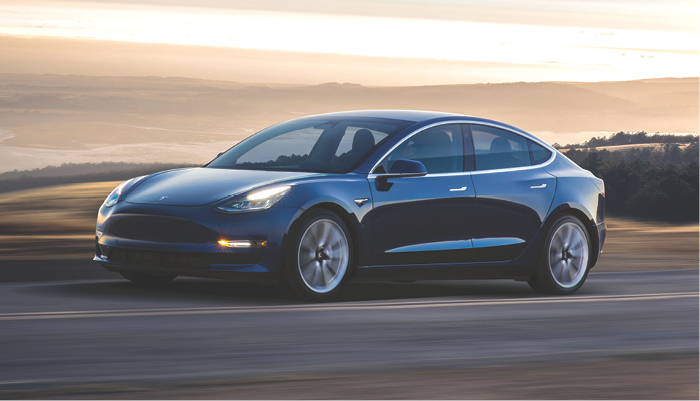All
Tesla Model 3: Definitely Innovative
by Ed Burke, Dennis K. Burke Inc.

At a ceremony held in August, 30 employees of the Tesla team received the first deliveries of Model 3 sedans. The Tesla Model 3 has been one of the most anticipated new cars in years – the company’s first mass-market vehicle. Without traditional marketing (or a test drive), Tesla has taken around 500,000 money-down “reservations” for their new Model 3, with buyers knowing they may not get their car until later in 2018.
Getting A Closer Look
Right away, you’ll notice the Model 3’s full-glass roof running from the front all the way back to the trunk. The front end is very distinctive and gets some mixed reviews. Eliminating the grille, the contoured hood and the pulled back headlamps give the car an aerodynamic look.
“Wow!” is the only way to describe the Model 3 interior. There are no switches, knobs or gauges on the dashboard. In fact, there aren’t even any air vents. In their place is a 15” touchscreen that displays everything from speed and battery life, to navigation and climate control settings. A really neat feature is the single thin opening in the dash that blasts hot or cold air into the cabin – no more individual vents. You can easily control the air with the touchscreen by swiping over the part of the car where you want the AC or heat directed. And then there’s voice-activated controls too.
The Model 3 is definitely innovative, but not quite groundbreaking. The Tesla Model S was the first long-range electric car in mass production, and the Chevy Bolt EV was the first 200-mile-plus electric car under $40,000.
EV Charging Options
You may have heard about Tesla’s Supercharger network of charging stations across the country. The manufacturer says they’re expanding the number of chargers in North America to 6,500 by the end of the year. For Model 3 owners, there is a pay-per-use fee. Using the Tesla Superchargers, EVs can recover 130 to 170 miles in about 30 minutes.
Then of course, there are plenty of EV chargers around the city. At home, Tesla recommends its 240-volt Wall Connector for the fastest home charging – a 120-volt power source takes considerably longer to charge.
The Price Tag
Only the $44,000 rear-wheel-drive version, with a long-range battery and the $5,000 Premium Upgrade package, is available now. This sedan offers a range of about 310 miles on a single charge, reaches a top speed of 140 mph, and goes from 0 to 60 mph in just 5.1 seconds.
The much-anticipated “standard” $35,000 Model 3 should be available in November. It has a range of about 220 miles, with a top speed of 130 mph, and goes 0 to 60 mph in 5.6 seconds.
Tesla says the dual-motor all-wheel-drive configurations will be available early next year. Standard features include automatic emergency braking and collision avoidance, a smartphone keyless entry, Wi-Fi and LTE connectivity, backup camera, onboard maps and navigation, and voice-activated controls. Model 3 gets over-the-air updates of core vehicle-system software, and it comes with hardware to support Tesla’s second-generation Autopilot system that you can activate for $5,000.
Worth noting, all colors but black will cost you $1,000 extra, and 19” Sport wheels will cost you an extra $1,500.
Beyond that, the $5,000 Premium Upgrade package has all of the bells and whistles that you could imagine – and then some. The price tag for a fully loaded Model 3 with all of the options seems a little expensive at just over $60,000.
What About The Tax Credits?
Not everybody will be eligible for the full $7,500 federal tax credit. Once Tesla hits its ceiling of 200,000 total deliveries in the U.S., the tax credit is phased out incrementally. Tesla is expected to reach that number in 2018. Ten states offer credits or rebates that further reduce the EV’s price tag. Nearly half of U.S. plug-in sales to date were in California, which had to drastically scale back its program due to lack of funding.
Tesla said in a recent investor newsletter that the Model 3 has been designed to be affordably priced and to provide compelling customer value, even without government incentives.
However, even if the automaker doesn’t run into any more delays, ramping up production of Tesla’s first mass-market sedan seems like a tall order. The Tesla team expects to be producing 5,000 cars per week by the end of the year, and projects about 500,000 cars a year by the end of 2018.
Related Posts
 Remote Tank Monitoring Supports Better Decision-Making and Operational Efficiency
Remote Tank Monitoring Supports Better Decision-Making and Operational Efficiency
Posted on August 18, 2025
 What’s Next in Boiler Technology
What’s Next in Boiler Technology
Posted on June 25, 2025
 Data Delivers!
Data Delivers!
Posted on April 28, 2025
 Harnessing Payment Data to Increase Profitability
Harnessing Payment Data to Increase Profitability
Posted on March 10, 2025
Enter your email to receive important news and article updates.
